In my last post I described how we are overhauling our whole game's art style in two months and limited budget, and this time I want to focus specifically on the character models. Given the story and character-driven nature of the game, getting these right was one of the most critical parts of development.
The Originals, and why they changed
The original art direction called for much more simplistic and blocky style, with the characters made of differently shaped cubes. Although they were really my own programmer art, I spent some time tweaking them to get the proportions right and draw from inspirations such as 30 Flights of Loving without merely aping Blendo's style.
I liked my models. But others didn't. Most feedback reported them as being too childish and Minecraft-y, making the game feel childish. Needless to say, my artistic confidence was shot and after much deliberation I caved into changing them. Even though I miss my little cube people, I realized they were pre-emptively putting off my target players and creating a wrong impression of the game. The new style fits the tone and message better.
Lesson learned - sometimes you have to suck up your own personal preference / ego, and go with what is best for your game.
The Approach
As with the graphical overhaul, we had limited time to work on the new characters. In the end we managed to revamp a cast of about 19 characters in just two and a half weeks, a pretty spectacular feat! But we were careful in our approach and definitely cheated our way around some things.
The Design: we spent a few days merely talking and experimenting. My artist made a small presentation of the different styles with references, a great visualization tool for my non-artistic self. When it came to implementation, however, our chosen approach did not work out so well and we switched to the next option we were happy with. It may seem like a waste of time, but we wouldn't have known it didn't work until we tried it. We could move forward in confidence that our new style was the best choice.
The Research: aside from discussing the different styles, I also gave my modeler a whole zip file of different references. Both for specific characters, as well as generic people of the period (like stewards) or particular items of clothing (such as the Captain's hat). This was immensely useful and filled in for lack of a concept artist.
The Modeling: The plan was to create a base male and female model we could swap different textures on as well as separate 'attachable' such as heads, hair, beards, hairs, glasses or scarves. This cuts down on the work required, for both modeling AND rigging, and creates a nice set of pieces to create variety. Plus, it set us up for easily integrating some planned additions later, such as different facial expressions.
The Animations: To get the characters moving, we used Unity's own FREE Row Mocap data. It's not perfect by any means, but it's hell of a lot better than no animations, as we knew we couldn't afford those yet. A necessary compromise that worked out great in the end.
The process frankly turned out better than I anticipated, and here's a few extra lessons we learned.
Trust your artist
I already stressed the importance of getting the right person for the job in my previous post. During our design talks, it became clear I was not as imaginative and visually inclined as my modeler and could not envision the final outcome without seeing it. Thus, after we established a good direction, my further guidance was honestly simply getting in the way of progress so I pulled myself back and let my artist do his thing. A few days later I got the first batch of new characters, and couldn't have been happier. Let the artist be an artist.
I also delegated tasks even if it cost more money. I tried setting up the animations in Unity and quickly realized I didn't know what I was doing. I finally let my modeler do it. Since Rafael was familiar with Unity and was already rigging the chars, it avoided a lot of unnecessary back-and-forth and overhead. It cost extra, but it saved time which was in this case more valuable.
Cheat, but cheat smartly
We needed 19 characters total, yikes! But luckily we figured there are more ways to create variety than just new models, and took advantage of that.
- We used characters with the same clothes and only different faces BUT we spread them apart in the narrative so the repetition would not become noticeable.
- We used various generic attachable (hats, glasses, beards) to create variety. And we multiplied that further - tweaking the unity material color can change a hairdo easily, and a scaled down beard makes an excellent goatee.
- If an attachable or a face didn't work for a given character, we didn't delete it, but retrofitted it for a less important NPC.
- We used the same stock body textures with altered hue to create fresh looking outfits or skin tones. The simplest of hacks.
Cut features, but remember the big picture
Of course, given the blitzingly short dev time, we had to give up some ideas. The big one was to create 4 different faces for each character to alternate in conversations; we simply ran out of time. But since we plan to still add it after Beta, we already set up our models and heads to easily allow that in the future with quick deforms. Similarly, we had to make two sitting characters standing since the raw mocaps did not have a sitting animation. But since we used a standard rigging system, we can easily purchase (or make) sitting animations in the future.
So if you have to cut, consider which cut features can be re-added later and take the extra time to make sure you setup a system to support them later. Just as with cheating, if you gotta cut something, cut it smartly.
Conclusion
In retrospect, the task of overhauling 19 characters from scratch in mere two and a half weeks is a ridiculous proposition, so the fact we somehow managed it was a miracle. However we sure did our best to facilitate the miracle happening, and it was a combination of a smart approach, a driven artist, and many cut corners that let us get through.
And because we did our research and skimmed pretty intelligently, we did not box our selves in. We created plenty of room for future improvement when we get to the second art pass on these!
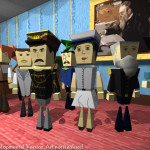
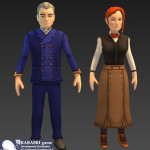
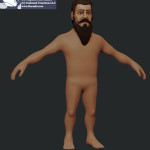
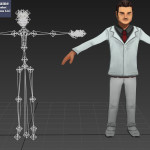
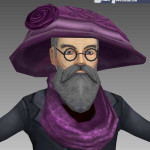
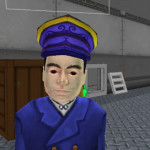
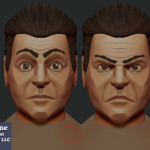



Very impressive work!
I really like the new models! And it's very nice from you to listen to the community :)